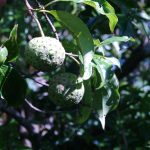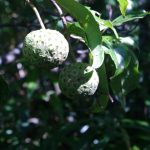|
Cornus sunhangii T.Deng, Z.Y.Lv & Zhi M.Li, Phytotaxa 409: 277 (2019);
. Tibet as per POWO; .
The Cornus we large trees in amongst Quercus lamilosa forest. The majority of the fruit had dropped to the ground and shown no signs of turning another colour beyond green. Our guides ate the fruit although they were not quite ripe. They were clearly Cornus but not of a speciea I am familiar with.
Looks like Cornus kousa to me. Recently reported as a new record to India from Sikkim. Thank you for your help. This is most definitely not Cornus kousa. The fruit are much bigger and drop green. Cornus kousa has red fruit that are smaller only 1-1.5 cm diameter. http://www.efloras.org/florataxon.aspx?flora_id=2&taxon_id=242443980
The largest of these fruit were over 4 cm in diameter. Nor does this key out to be Cornus capitata. I will certainly follow up your Taiwania link. The Taiwania article is very interesting and the fruit look remarkably similar. Interesting that the fruit are also Thanks for writing me back. As the Taiwania paper mentions, Cornus is represented by only 3 (+1 as C. kousa) species in India., I too think your plant could be a new record to Manipur. Other three species do not match well with your photographs. Mentioning below the differentiating characters along with the links which you can check with your photographs/specimens.
Cornus capitata: Leaf blade narrowly elliptic or oblong-lanceolate. Fruits pubescent with small white trichomes.
Cornus elliptica: Fruits globose, but leaves abaxially white pubescent.
Cornus oblonga: Fruits onlong. I was with … in Manipur. What’s interesting about this Cornus is that it doesn’t quite fit with any Asian Cornus I can think of, or find described. It is clearly close to C. capitata, which is common here in the UK from many introductions, over a very long period, from right across its natural range. Kingdon-Ward mentions finding C. capitata on Sirhoi in 1948, which will undoubtedly be this same taxon as Khorrung is a stone’s throw from Sirhoi. But I have measured the fruit at up to 6cm across (… was being conservative!). C. capitata fruit are described as 1.5-2.5cm diameter, purple-red at maturity and ‘densely covered in white trichomes’, unlike ours – these dropped green as … photos show. The fruits are ‘flattened globose’, as per C. capitata. It showed every sign of being fully evergreen, unlike C. kousa. It made trees up to perhaps 9m tall, unlike any C. kousa subsp. kousa. The very few flowers we saw (aberrant autumn flowers on part of one tree only) were white, unlike the pale yellow usually seen on C. capitata, though some are described as ‘whitish’. C. capitata foliage is described as being abaxially ‘densely pubescent with thick, white, appressed trichomes’. Our plant is abaxially glabrescent, with very few tiny hairs, feeling almost smooth to the touch. C. capitata has leaves adaxially ‘grey-green’, whereas ours are green. Cornus oblonga is a very different plant.
C. elliptica, only know from China, is, as you point out, with leaves abaxially white pubescent. The abaxial hairs are more abundant than in C. capitata, making them feel rougher. It has leaves adaxially glossier green than C. capitata, like our plant. It again has fruits only ‘1.5 to 2.5cm diameter’ and ‘globose’. Again densely covered in white trichomes, unlike ours.
It fits none of the Cornus described from India and as far as I can tell, anything else!
See attached further photos. Thanks … for digging this more deep. I agree that the fruits are much bigger and leaves are different too. I could not guess the fruit’s size with the previous photos. Definitely it is not C. kousa ssp. kousa. Let us know if you describe it as a new species. Sorry for confusion, but I completely neglected to consider C. hongkongensis. It would seem this is the closest candidate, but the fruit are still much larger than anything so far recorded. If it does turn out to be this species it would about as disjunct a population as the C. kousa kousa in Sikkim!! I must say, I find it very difficult to believe C. kousa subsp. kousa would be found in Sikkim considering it is only known from Japan and Korea and with C. kousa subsp. chinensis geographically in between. I wonder whether there may be a connection between these Manipur plants and the Sikkim find. I also wonder if the Sikkim plants are catagorically, definitely deciduous. Thanks for reminding me of this species, … I am asking the help of Dr Jenny from NCSU, USA who has extensively worked on Cornus. Hope I’ll get an answer soon. this turned out to be the newly described Cornus sunhangii, according to Jenny. . Posted in 2013. Published new species in 2019.:
. References: POWO |
Disclaimer
1. For any mistake in identification or for becoming efloraofindia e-group member (for contributing towards building of efloraofindia or otherwise), pl. mail to indiantreepix@googlegroups.com or itpmods@googlegroups.com
2. For better viewing of species’ pages, colour scheme & formatting is being followed as: Description of the species, Details of other flora species on the same page, Uses/ harms, Distribution, Abundance/ Location/ Flowering time & date, Habit & habitat, Etymology & pronunciation, Other interesting information, stories etc., Others, Botanical names, Common names, Main point of discussion below, Discussion about Botanical names.
Navigation
- Award for eFloraofIndia
- Colour scheme & formatting
- Copyrights, Permissions, Citations
- eFloraofIndia appreciated
- Names of Plants in India site
- Flowersofindia site
- Posting Guidelines
- For members’ information
- Logo, Tagline, Acronym
- Volunteers required
- ‘Pitamah’ of eFloraofIndia
- ‘अजेय’ ‘Ajey’ of eFloraofIndia
- ‘Saarthi’ ‘सारथि’ of eFloraofIndia
- ‘Jewel’ of eFloraofIndia
- ‘Grassman’ of eFloraofIndia



